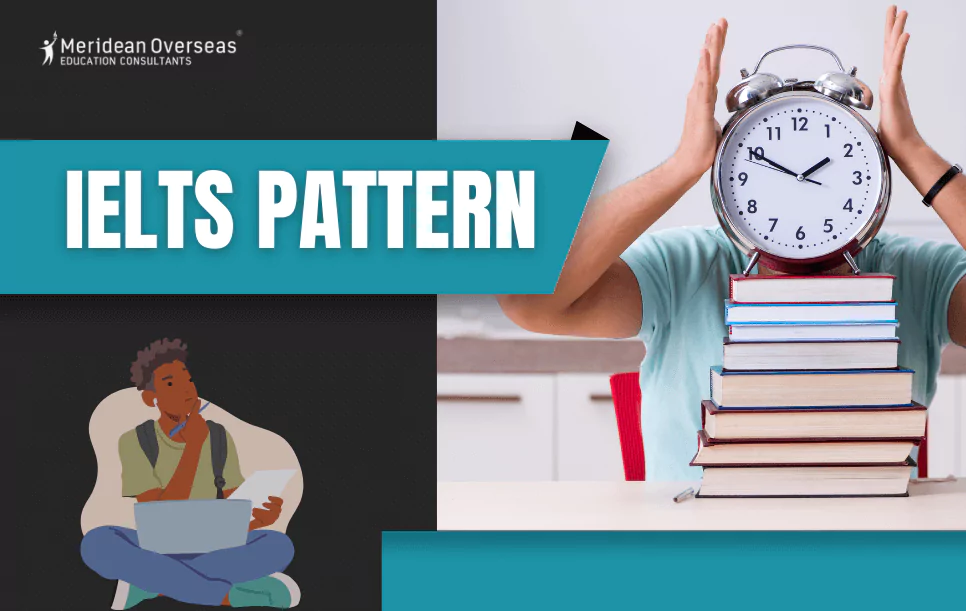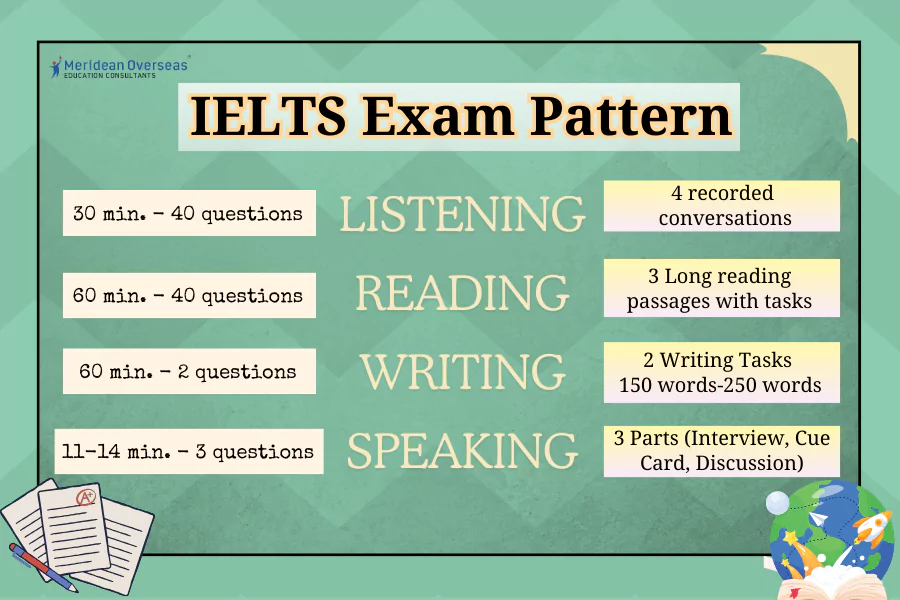
Announcements

Announcements

The IELTS exam pattern for 2025 has four sections: Listening, Reading, Writing, and Speaking, serving as extensive evaluators of your English proficiency. The exam comes in 2 distinct formats – IELTS Academic and IELTS General – each catering to diverse pursuits.
IELTS Academic is widely accepted by universities globally, particularly for those seeking admission to a bachelor's or master's. You must meticulously check the proficiency requirements of your desired university, tailoring your preparation accordingly.

IELTS Exam Pattern 2025
IELTS Paper Pattern
IELTS Test Format
FAQs
In contrast, individuals planning to migrate to major English-speaking countries or settle for work opt for IELTS General Training. The versatility of IELTS extends to its acceptance by professional organisations seeking English proficiency scores from those whose native language is not English.
You should understand the distinct demands of each section and align your preparation with the targeted format, navigating the IELTS Pattern.
Prior to its detailed look in the syllabus, you have to look at the IELTS test format and start preparing for the test.
The IELTS test score is paramount in selecting various educational and professional prospects. It is a jointly owned venture by the British Council, IDP IELTS, and Cambridge English Language Assessment.
Widely recognised, IELTS is accepted by over 10,000 institutes across more than 140 countries, affirming its global relevance and credibility in assessing English proficiency.
All the IELTS sections will be assessed in a single setting. Yet, the Speaking section can be evaluated on the same day as the other sections or within a seven-day window preceding or following the exam date. This flexibility in scheduling the Speaking test gives you a convenient and adaptable approach to showing your oral English proficiency.
|
Test Section |
Duration |
Description |
Total Questions |
|
Listening |
30 minutes |
Four recorded monologues and conversations |
40 |
|
Reading |
60 minutes |
Three long reading passages with tasks. Texts range from descriptive and factual to discursive and analytical, including non-verbal material like diagrams, graphs, and illustrations. Texts are authentic and sourced from books, journals, and newspapers. |
40 |
|
Writing |
60 minutes |
In Writing Task 1, summarise, describe, or explain a table, graph, chart, or diagram in at least 150 words. In Writing Task 2, write a short essay of at least 250 words. |
2 |
|
Speaking |
11-14 minutes |
Face-to-face interviews include an introduction, a cue card, and a detailed discussion. |
3 |
After learning about the IELTS Pattern, you must also deeply look into its complete syllabus. The test lasts 2 hours and 45 minutes, whether computer-based or paper-based. So, let’s start understanding the paper pattern by section.
Listening Section: The IELTS listening has a total duration of 30 minutes, during which you will engage in 4 distinct questions. In each part, you will encounter a diverse range of task types, totalling 40 questions overall. These questions evaluate your ability to comprehend spoken English in various contexts, including conversations, lectures, and discussions.
Reading Section: The IELTS reading consists of 3 texts of general interest tailored to the intellectual level expected of those pursuing post-graduate or undergraduate programs. You are allotted 60 minutes to complete this section and respond to approx. 40 questions. The questions cover a spectrum of comprehension and analytical skills, requiring you to extract information, infer meanings, and critically engage with the provided texts.
Writing Section: You are allocated 60 minutes for the writing section, where you will undertake two tasks. Task 1 entails composing a summary based on information derived from a graph, table, or process. You must produce a summary of at least 150 words. In Task 2, you must construct a discursive essay with a minimum length of 250 words. This task analyses your ability to articulate and develop arguments effectively in written English.
Speaking Section: The IELTS speaking spans a variable duration, ranging from 11 to 14 minutes. During this time, you participate in a face-to-face interview, wherein your oral communication skills are evaluated. The interview aims to examine your proficiency in expressing ideas coherently in English. This section is a practical demonstration of your ability to communicate effectively in real-life scenarios, contributing to an overall evaluation of your language skills.
The IELTS exam comes in two types of versions - Academic and General Training. Everyone takes the same Listening and Speaking tests, but the Reading and Writing tests are different for each type.
So, it's important to prepare for the right kind of test you're going to take. Academic and General Training have their own specific Reading and Writing parts, and getting ready for the correct one will help you do better.

In this section, you will be listening to four recordings of native English speakers and writing your answers to the questions list.
Recording 1: Everyday Social Conversation
Type: Interactive dialogue
Participants: Two people engaged in conversation
Context: Everyday social situations
Objective: Evaluate your ability to understand and grasp information in informal discussions. You must comprehend natural conversational language, including expressions, opinions, and contextual cues.
Recording 2: Everyday Social Monologue
Type: Single-speaker monologue
Speaker: One person delivering a monologue
Context: Everyday social settings
Objective: Assess listening skills when a speaker provides information or expresses thoughts in a monologue format. Test takers need to understand details, opinions, and the speaker's purpose.
Recording 3: Educational or Training Conversation
Type: Group dialogue
Participants: Up to four people involved in a conversation
Context: Educational or training environment
Objective: Test the ability to comprehend information in more formal discussions, where multiple speakers may contribute to the conversation. Evaluate how well test takers can follow content and opinions in an academic or training context.
Recording 4: Academic Monologue
Type: Single-speaker monologue
Speaker: One person delivering a monologue
Context: Academic subject
Objective: Assess listening skills in an academic context, where the speaker discusses a topic with depth and complexity. Test takers must understand academic language, complex ideas, and the speaker's argument or perspective.
Types of IELTS Listening Questions
Matching
Multiple-choice questions
Sentence completion
Short answer questions
The IELTS Reading is a comprehensive evaluation tailored to assess your proficiency in reading skills. With 40 questions, this section encompasses diverse challenges to gauge your ability to comprehend written English effectively.
IELTS Reading questions are strategically crafted to measure skills such as understanding logical arguments, identifying main ideas, and extracting specific details from the given texts. This segment features three lengthy texts, carefully curated to span the spectrum from factual and descriptive to discursive and analytical content.
The chosen texts are sourced from reputable publications, including magazines, journals, newspapers, and books—materials that mirror the complexity and diversity encountered in university-level reading materials. Aspiring university students are thus presented with an authentic preview of the reading demands they may encounter in academic settings.
The texts follow the typical format of IELTS exams and reflect styles and genres found in academic literature. This alignment ensures that the Reading section effectively assesses your ability to navigate and understand higher education-related material.
Therefore, the IELTS reading includes various reading questions, reinforcing the multifaceted nature of the assessment and providing a complete measure of your reading proficiency.
Types of IELTS Reading Questions
Identifying information
Matching features
Sentence completion
Short-answer questions
Identifying the author’s claims
In the Writing section of the IELTS exam, tailored for individuals seeking admission to undergraduate and postgraduate programs, you are allocated a total of 60 minutes to complete two distinct tasks. Task 1 spans 20 minutes, and its nature varies between the IELTS Academic and General Training Modules.
For the IELTS Academic Module, Task 1 involves composing a summary of a table, graph, or process. You must craft a concise yet informative summary of at least 150 words based on the visual data provided. On the other hand, the IELTS General Training Module requires you to spend the same timeframe writing a letter with a minimum length of 150 words.
Task 2, common to both modules, requires you to dedicate 40 minutes to crafting an essay of at least 250 words. This essay prompt may involve responding to an argument, addressing a problem, or expressing a viewpoint. You must respond formally, showcasing your ability to articulate well-reasoned and coherent arguments.
The topics covered in both tasks are chosen to suit the academic aspirations of your goal of joining universities, ensuring the relevance and applicability of the writing section to your educational activities.
The Speaking section of the IELTS exam assesses your spoken English and is recorded for evaluation.
Part 1: Lasting 4 to 5 minutes, the examiner asks general questions about your background, work, studies, or home. This part evaluates your ability to engage in everyday conversations.
Part 2: You will receive a card with a specific topic, have one minute to prepare, and speak for two minutes. One or two follow-up questions from the examiner assess your ability to express ideas coherently within a limited time.
Part 3: Building on Part 2, this section involves a four-to-five-minute discussion on the chosen topic, exploring more profound ideas and issues. It evaluates your proficiency in articulating complex thoughts and opinions.
These three parts collectively comprehensively evaluate your spoken English skills, covering fluency, coherence, vocabulary usage, and overall communicative effectiveness. The recorded format ensures your accurate and consistent assessment.
1. What is the passing band score in the IELTS exam?
The IELTS exam does not have a universal passing band score. Institutions and organisations set their score requirements. Requirements vary, with universities and colleges typically requiring scores between 6.0 to 7.0 or above for academic programs and immigration authorities establishing specific criteria for visa applications. You should check the specific requirements of the institution or organisation you are applying to.
2. How many IELTS Tests Report Forms (TRFs) can I get?
You will receive only one set of the Test Report Form (TRF). However, the administrative body will transmit your IELTS score (TRF) to a maximum of 5 universities specified in your IELTS application.
3. What tips can be beneficial for the IELTS Writing section?
Achieving a strong band score in the IELTS Writing section demands exhaustive preparation, given that even native speakers can encounter challenges in grammar, punctuation, and spelling. You must focus on enhancing your grammar, use a logical and well-structured approach, facilitate your spelling mistakes, and make sure to be consistent in ideas.

Contact MOEC Experts for Study Abroad Guidance!

MOEC